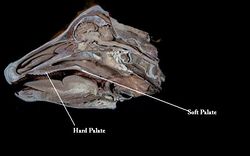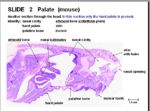Difference between revisions of "Hard Palate"
Jump to navigation
Jump to search
(→Links) |
|||
| Line 26: | Line 26: | ||
==Links== | ==Links== | ||
| − | Click here for the [[Cleft Palate|Pathology of Cleft Palate]] | + | Click here for the [[Cleft Palate|Pathology of Cleft Palate]] |
[[Category:Oral Cavity - Anatomy & Physiology]] | [[Category:Oral Cavity - Anatomy & Physiology]] | ||
[[Category:To Do - AimeeHicks]][[Category:To Do - AP Review]] | [[Category:To Do - AimeeHicks]][[Category:To Do - AP Review]] | ||
Revision as of 17:00, 10 December 2010
Overview
The hard palate (palatum durum) forms the rostral roof of the oral cavity. It merges caudally with the soft palate where a connective tissue aponeurosis replaces the bone.
Structure and Function
The hard palate is the bony shelf of the palatine processes of the incisive, maxillary and palatine bones. Failure of the palatine bones to fuse results in cleft palate. There are 6-8 fixed transverse ridges to direct food caudally. The hard palate is flat and has incisive papilla (small median swelling) behind the incisive teeth and smaller papillae ducts branching to the nasal cavity and vomeronasal organ.
Histology
- Thick mucosa
- keratinised stratified squamous epithelium
Species Differences
Herbivores
Herbivores have a more heavily keratinised hard palate.
Feline
Felines have short a hard palate.
Links
Click here for the Pathology of Cleft Palate

